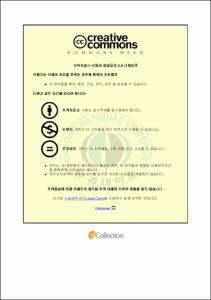터널의 동적거동에 관한 연구
- Alternative Title
- A Study on the Dynamic Response of Tunnel
- Abstract
- 본 연구는 터널의 양단자유, 양단고정의 단부 경계조건에 대하여 모드중첩법의 적용성을 확인하고 이를 검증하기 위해 종방향 해석방법인 St.John and Zahrah와 Hashash(2001)등의 제안식과 비교하였다.
터널은 탄성기초 위에 놓인 연속보로 모형화 하였으며, 지진파는 일정속도로 지표에 전파되는 정현파 형태의 지반변위로 적용하였다. 터널의 축방향과 축직각방향에 대해 연구를 수행하였으며, 동적해석법은 시간영역해석인 모드중첩법을 적용하였으며 동적거동에 영향을 주는 매개변수들의 영향을 규명한 후 다음과 같은 결론을 얻었다.
1. 축방향 양단자유 단부경계조건을 가진 터널에 대해 El-Centro 지진 기 록을 이용 하였으며 St.John and Zahrah와 Hashash(2001)등의 제안식 에 의해 얻은 축방향 변형률값과 모드중첩법으로 얻은 값을 비교한 결 과 1.03%의 차이만을 보이므로 매우 유사함을 확인할 수 있어 본 해석 법을 검증하였다.
2. 터널의 자유진동
지반강성이 높은 경우(>1×1010 N/m/m)에는 강성이 증가함에 따라 고 유진동수는 증가하며 지반강성이 낮은 경우(<1×1010N/m/m)에는 어느 한계 값까지 일정하게 유지되며 진동 모드수가 증가할수록 증가한다.
터널의 탄성계수가 1×1010N/㎡보다 작은 값에서는 고유진동수에 미치는 영향이 없으나 1×1010N/㎡보다 높은 값일 경우에는 고유진동수가 증가 하며 진동모드수가 증가할수록 고유진동수는 급격히 증가하고 축방향 자유진동에서 그 경향이 뚜렷이 나타난다. 터널의 횡단면적과 관성모멘 트가 증가함에 따라 고유 진동수는 증가한다. 터널의 길이가 증가함에 따라 고유진동수는 감소하고 길이가 100m이하인 경우 모드수가 증가할 수록 고유진동수는 급격히 증가한다.
3. 터널의 동적응답은 파가 터널을 완전히 통과하기 전에 나타나는 일시적 응답과 통과 후의 정상상태 응답오로 나타나며 일시적 응답은 전파속도가 빠를수록 불분명해진다.
터널의 축방향 및 축직각방향에 대한 동적응답 해석에서 터널의 모드에 따른 파장과 지진파의 파장이 같아지는 공진현상을 확인할 수 있었으며. 이때의 모드수(k)는 축방향 양단자유는 , 양단고정은 으로 여기에 10개의 모드를 추가함으로서 전반적인 동적거동을 확인할 수 있다. 하지만 축직각방향의 경우 값이 0으로 수렴함에 따라 7개의 모드만이 고려되었다.
4. 축방향의 양단자유의 경우 끝단에서 가장 큰 변위응답을 가지며 중앙부에서 가장 낮은 변위응답을 보이고 양단고정의 경우 양 끝단에서는 최소이고 중앙지점 좌우편에서 최대응답을 보인다. 축직각방향은 축방향과 유사한 거동을 보이지만 최대응답이 발생하는 위치는 차이를 보인다. 이상과 같은 결과들로부터 터널의 단부조건에 따라 변위응답은 각각 다른 양상을 보이며 최대 변위응답이 발생하는 위치도 터널의 단부조건에 따라 달라짐을 알수있다. 따라서 현재까지 주로 적용하고 있는 터널 중심부에서의 동적응답으로 터널을 설계함에는 다소 무리가 있음을 알 수 있다.
5. 일시적 변형률도 변위응답과 마찬가지로 터널 길이의 85% 이후에서는 일시적 변형률응답이 감소하여 정상상태 변형률응답이 발생되는 것을 나타낸다. 대칭구조를 이루는 축방향과 축직각방향의 양단자유 경계조건에서 지점별 변형률응답이 대칭적으로 나타나는 것을 볼 수 있다.
6. 지반-구조물 상호작용에 의한 감쇠비를 20%, 50%, 80%로 적용하였고 지반-구조물 상호작용에 의한 감쇠비()는 관 단부조건의 변화에도 터널의 동적거동에 영향을 주지 않는 것으로 나타났다. 이런 현상은 터널의 동적응답이 지반의 동적응답보다 작게 발생하므로 타당한 결과로 판단된다.
7. 터널의 최대 변형률응답을 나타내는 파장을 임계파장이라고 정의하면 임계파장보다 더 큰 파장에 대해서 변형률은 감소하며, 결국 0으로 수렴하는 경향을 나타낸다. 단파에 있어서 전파속도가 클수록 변형룰은 커지므로 전파속도의 영향이 커지며 모든 터널의 단부 경계조건에 관계없이 적용되어질 수 있다.
This work reports results of our study on the dynamic response of the straight tunnel both along the axial and the transverse direction for both the free and forced vibration with a boundary condition of the fixed ends and the free ends, respectively. In order to investigate the response on earthquake, the resulting natural frequency and mode shape obtained from the free vibration have been utilized to complete the derivation of mathematical formula for the forced vibration.
The natural frequency varies most significantly by the soil stiffness and the length of the tunnel, which shows a increasing trend with increasing the soil stiffness while decreasing with increasing the length of the tunnel. Also curved tunnel is the most necessary and essential part for actual designing. So our study shows that construction method of curved tunnel and an example for being used curved tunnel.
The dynamic behavior of the tunnel for the forced vibration is found to exhibit two different forms, a transient response and a steady state response, depending on the time-displacement relation of the vibration. The former is identified by the slight change in its behavior before the sinusoidal-shape wave traverses through the whole length of the tunnel whereas the latter by the complete form of a sinusoidal wave after traversing the tunnel completely. The transient response becomes insignificant as the wave speed increases.
We have studied the effect of the mode number on the dynamic behavior for wave velocities(100m/sec, 300m/sec, 500m/sec, 2000m/sec) and frequencies of the ground motion(30rad/sec, 100rad/sec). Any changes by the mode effect are found only on the lower modes. The corresponding effect on the higher modes appears as a resonance only along the axial direction of the tunnel when the natural frequency matches with the frequency of the ground motion for the forced vibration.
The maximum strain occurs in the middle of the tunnel with a boundary condition of the free ends, whereas it occurs at the fixed both ends of the tunnel with the fixed ends.
- Issued Date
- 2009
- Awarded Date
- 2009. 2
- Type
- Dissertation
- Publisher
- 부경대학교 대학원
- Alternative Author(s)
- Jin, Jong-Ta
- Affiliation
- 부경대학교 대학원
- Department
- 대학원 토목공학과
- Advisor
- 정진호
- Table Of Contents
- 1. 서론 = 1
1.1 연구배경 및 목적 = 1
1.2 연구동향 = 2
1.3 지중구조물의 내진설계규정 = 4
1.4 연구방법 및 범위 = 7
2. 터널의 자유진동 = 8
2.1 축방향 자유진동 = 8
2.2 축직각방향 자유진동 = 13
2.3 자유진동수에 대한 매개변수의 영향 = 22
3. 터널의 강제 진동 = 31
3.1 지반 운동 = 31
3.2 모드중첩법에 의한 강제진동 수식전개 = 35
3.3 종방향 지진해석법에 의한 강제진동 수식전개 = 51
4. 터널의 동적응답 = 58
4.1 터널의 동적 변위응답 = 58
4.2 터널의 동적 변형률응답 = 63
4.3 수치해석 결과의 정확성 인자 = 66
4.4 터널의 지점위치별 변위와 변형률 응답 = 69
4.5 동적해석 매개변수 연구 = 76
5. 해석 결과의 검증 = 80
6. 결론 = 85
참고문헌 = 88
- Degree
- Master
- Files in This Item:
-
-
Download
 터널의 동적거동에 관한 연구.pdf
기타 데이터 / 14.34 MB / Adobe PDF
터널의 동적거동에 관한 연구.pdf
기타 데이터 / 14.34 MB / Adobe PDF
-
Items in Repository are protected by copyright, with all rights reserved, unless otherwise indicated.